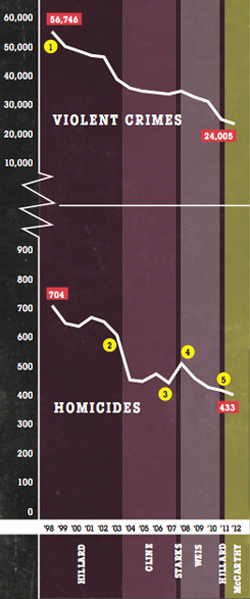 Although the trend lines look encouraging, crime rates have not fallen in Chicago as dramatically as elsewhere. The city was named the murder capital of America in 1998, 2001, and 2003. (That title reflects annual totals, not per capita rates; by that metric, cities like Detroit and Baltimore typically rank high.) Judging success or failure by stats alone, however, is a cautionary exercise: Past CPD chiefs have seen numbers decrease early in their tenures, but that progress has proved difficult to sustain.
Although the trend lines look encouraging, crime rates have not fallen in Chicago as dramatically as elsewhere. The city was named the murder capital of America in 1998, 2001, and 2003. (That title reflects annual totals, not per capita rates; by that metric, cities like Detroit and Baltimore typically rank high.) Judging success or failure by stats alone, however, is a cautionary exercise: Past CPD chiefs have seen numbers decrease early in their tenures, but that progress has proved difficult to sustain.
1. In early 1998, Terry Hillard took the reins of the Chicago Police Department during a period of high, if declining, violence. Homicides fell the next year, following broader national trends.
2. In April 2003, Phil Cline replaced Hillard and nearly finished the year with fewer than 600 murders, which hadn’t happened in Chicago since 1967.
3. Murders reached a low of 448 in 2007. But by the end of the year, Cline was on his way out in the wake of scandals involving bad behavior by some officers, including a few in the specialized units.
4. Early in Jody Weis’s tenure, both murders and violent crimes spiked, the former breaking the 500 mark again. The pressure on Weis, due in part to his decisions to substantially remake aspects of the department, peaked too.
5. After Weis’s difficult start, homicides and violent crimes began to fall again. In 2011, murders reached a new low of 433, but Weis would not be around to take credit: Rahm Emanuel’s victory led to his resignation in March of that year.
RELATED: Garry McCarthy Under the Gun? »
NOTES: In Chicago, violent crime figures include murder, sexual assault, aggravated assault and battery, and robbery. Data are annual totals ending each calendar year. SOURCE: Chicago Police Department


